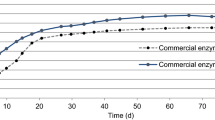Abstract
To have all-year-round available feedstock, whole-crop maize is harvested premature, when it still contains enough moisture for the anaerobic ensiling process. Silage preparation is a well-known procedure for preserving plant material. At first, this method was applied to obtain high-quality animal feed. However, it was found that such ensiled crops are very suitable for bioenergy production. Maize silage, which consists of hardly degradable lignocellulosic material, hemicellulosic material, and starch, was evaluated for its potential as a feedstock in the production of bioethanol. It was pretreated at low severity (185 °C, 15 min) giving very high glucan (∼100%) and hemicellulose recoveries (<80%)—as well as very high ethanol yield in simultaneous saccharification and fermentation experiments (98% of the theoretical production based on available glucan in the medium). The theoretical ethanol production of maize silage pretreated at 185 °C for 15 min without oxygen or catalyst was 392 kg ethanol per ton of dry maize silage.




Similar content being viewed by others
References
Thomsen, A. B., Medina, C., & Ahring, B. K. (2003). In H. Larsen, J. Kossmann, & L. S. Petersen (Eds.), Risø energy report 2 (pp. 40–44).
Hazell, P., & Pachauri, R. K. (2006). 2020 Focus No. 14, November. http://www.ifpri.org/2020/focus/focus14.asp#dl.
Eurobserver (2006). Biofuels barometer May, pp. 57–66.
EU (2007). Brussels European Council 8–9 March—Presidency Conclusions (http://mediacontent.ig.publicus.com/PDF/IG35268339.PDF)
Thomsen, M. H., Thygesen, A., Christensen, B. H., Larsen, J., Jørgensen, H., & Thomsen, A. B. (2006). Applied Biochemistry and Biotechnology, 129–132, 448–460.
Klinke, H. B., Olsson, L., Thomsen, A. B., & Ahring, B. K. (2003). Biotechnology and Bioengineering, 3(81), 738–747.
Olsson, L., & Hahn-Hagerdal, B. (1993). Process Biochemistry, 28, 249–257.
Schmidt, A. S., & Thomsen, A. B. (1989). Bioresource Technology, 64, 139–151.
McGinnis, G. D. (1983a). WWWMCE. Industrial & Engineering Chemistry Product Research and Development, 22, 352–357.
Lee, Y. V., Iyer, P., & Torget, R. W. (1999). Advances in Biochemical Engineering, Biotechnology, 65, 93–115.
Galbe, M., & Zacchi, G. (2002). Applied Microbiology and Biotechnology, 59, 618–628.
McGinnis, G. D., Wilson, W. W., Prince, S. E., & Chen, C. C. (1983b). Industrial & Engineering Chemistry Product Research and Development, 22, 633–636.
Bjerre, A. B., Olesen, A. B., Fernqvist, T., Plöger, A., & Schmidt, A. S. (1996). Biotechnology and Bioengineering, 49, 568–577.
Ahring, B. K., Licht, D., Schmidt, A. S., Sommer, P., & Thomsen, A. B. (1999). Bioresource Technology, 68, 3–9.
Palmqvist, E., Hahn-Hägerdal, B., Szengyel, Z., Zacchi, G., & Reczey, K. (1997). Enzyme and Microbial Technology, 20, 286–293.
Pedersen, C. Aa. (2006). Oversigt over Landsforsøgene 2006, Dansk Landbrugsrådgivning, Landscenteret-Planteavl (Danish).
Holm-Nielsen, J. B., Madsen, M., & Popiel, P. O. (2006). Proceedings: World Bioenergy 2006, Conference for Biomass for Energy, 05/2006, Jönköbing Sweden.
Weinberg, Z. G., & Munc, R. E. (1996). FEMS Microbiology Reviews, 19, 53–68.
Varga, E., Schmidt, A. S., Reczey, K., & Thomsen, A. B. (2003). Applied Biochemistry and Biotechnology, 104, 37–50.
Thomsen, M. H., Popiel, P. O., Lisiecki, P., Varga, E., Thomsen, A. B., Esbensen, K. H., et al (2005). Proceedings: 14th European Biomass Conference and Exhibitons, 17–21 October 2005, Paris, France.
Petersson, A., Thomsen, M. H., Haugaard-Nielsen, H., & Thomsen, A. B. (2007). Biomass & Bioenergy, 31, 812–819.
Martín, C., Klinke, H., & Thomsen, A. B. (2007). Enzyme and Microbial Technology, 40(3), 426–432.
Taherzadeh, M. J., Gustafsson, L., Niklasson, C., & Lidén, G. (1999). Journal of Bioscience and Bioengineering, 87, 169–174.
Taherzadeh, M. J., Gustafsson, L., Niklasson, C., & Lidén, G. (2000). Applied Microbiology and Biotechnology, 53, 701–708.
Acknowledgments
We thank Tomas Fernqvist from Risø National Laboratory. Dairy Farm, Farup Ribe is thanked for supplying good quality maize silage. Risø National Laboratory, Technical University of Denmark and Højteknologifonden, Denmark are thanked for financial support given to this study.
Author information
Authors and Affiliations
Corresponding author
Rights and permissions
About this article
Cite this article
Thomsen, M.H., Holm-Nielsen, J.B., Oleskowicz-Popiel, P. et al. Pretreatment of Whole-Crop Harvested, Ensiled Maize for Ethanol Production. Appl Biochem Biotechnol 148, 23–33 (2008). https://doi.org/10.1007/s12010-008-8134-2
Received:
Accepted:
Published:
Issue Date:
DOI: https://doi.org/10.1007/s12010-008-8134-2




